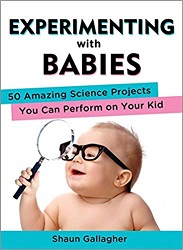
 Experimenting with Babies
Experimenting with Babies50 Amazing Science Projects You Can Perform on Your Kid
Reviewed December 29, 2018.
A Tarcherperigee Book (Penguin Random House), 2013. 205 pages.
Starred Review
2018 Sonderbooks Standout:
#4 General Nonfiction
I discovered this book when it was new to our library, and I’ve been reading it very slowly – just one experiment per day, if that – but lately I’m enjoying it so much, I’ve been telling every parent and grandparent I know about it. I would have had so much fun with this book back when I was a big sister with many younger siblings in the house to experiment on! (I was 3rd of 13. Though they weren't all in the house at the same time, I've been around babies a lot. They are super fun to experiment on!)
Here’s the idea: The author has taken serious science experiments that psychologists have tried on babies and tells parents how to adapt them and try them on their own kid. The experiments start with newborn reflexes and progress to experiments with language and following instructions for toddlers.
One thing I love about the book is that the experiments are not designed to tell you if your child is ahead or behind their agemates. The experiments are simply a fascinating look at human development in general and your baby in particular.
There’s really a wide variety of experiments. Let me describe a few of them – but consider this simply a random selection, and it will tend toward the older end of the experiments. (The beginning ones have to do with those fascinating infant reflexes.)
For example, one experiment has you ask two friends to greet each other in front of the baby. But then you do it again, later, but the second time, they greet each other with their backs turned to each other. The fascinating research is that 9-month-olds don’t react any differently to one or the other – but when researchers tried this (with a video) on 10-month-olds, they looked longer at the one with their backs turned. Somewhere in that time frame, babies figure out that people usually look at each other during social interaction.
I thought this one was really funny. For a child around 13-15 months, you put a toy on the table in front of you that you can activate with your head (causing some sort of light or sound). Then you put it in front of the baby, and see if they will activate it with their head or with their hands. The fascinating thing is that if you do it showing that your hands are full, the baby is less apt to use their own head to turn the toy on than if you do it with your hands empty and available. The baby seems to reason that the only reason you used your head was because your hands were full. But if your hands were free and you used your head anyway – then turning it on with your head must be what you’re supposed to do!
So those are the sort of silly experiments you’ll find here – silly but enlightening. Reading them really made me want to try them out on babies. (These are completely perfect Big Sister activities, but maybe I can convert them into Auntie activities.)
Human development is fascinating, and these experiments give you a little window into how your child is growing and changing and learning.
[And look at that! He's got a new book coming out in April: Experiments for Newlyweds.]

